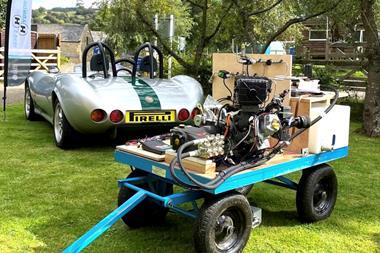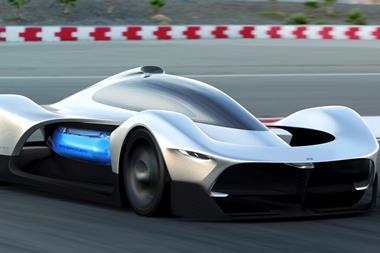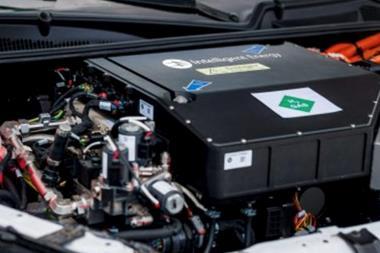Fuel cell electric vehicles will be the mainstay of vehicles in the future, according to Jon Hunt, manager of alternative fuels at Toyota.
During an enthralling presentation at Forecourt Trader’s inaugural Summit this week, he told delegates that Toyota believes “pure electrification is not the dominant route we should be taking, despite what your hear…”
But he also stressed that this is not just Toyota’s view - according to a recent annual survey of global automotive executives by KPMG, around 80% believe fuel cell electric vehicles (FCEV) will be the real break-through for electric mobility.
“What we’re seeing today is a rapid shift into battery, because in order to produce fuel cell power, you need to have an electric power train first, so that’s where the development is occurring, before moving to FCEV.
“Notwithstanding that, there are many manufacturers who have huge issues of achieving their emission reductions to avoid fines, that means that they have to have a certain proportion of zero emission cars. That is distorting the market…”
“Next year will see our second-generation Toyota Mirai – early in 2021 this car will be on the road. While not many manufacturers are on their first generation hydrogen vehicle, be certain and be sure that this sector is going to grow and expand.”
Hunt said that Toyota, as an engineering company producing many different products, had been working on various technologies for many years, and has sold more electrified vehicles than any other business: “We have around 14 million hybrid vehicles on the road, and have been selling these vehicles for more than 22 years, so we have a great deal of experience and understanding. We know that the key difference between these types of vehicles is the size, the weight, the cost and the chemistry of the battery that’s on the vehicle.”
He stressed that batteries have massive constraints in terms of the considerable resources needed to go into them, relative to the power they provide: “The bigger the battery you have to give you further range, means the more resources you use, the more energy you require, and the bigger and more detrimental it is in terms of the environment.
“All this development needs a lot of time and a lot of resources, so I don’t believe we will get anywhere near the volume of sales in terms of battery electric vehicles that are being forecast by politicians and others… There is not the production supply chain to do so.”
He also pointed out that there are around 1.2 billion people around the world today who have no access to grid electricity: “There is no possibility they will be serviced by battery electric vehicles.”
The programme on fuel cells at Toyota has been going on for about 40 years, but practically over the last 20-odd years it has been developing the products themselves, explained Hunt. And over those years it has refined and advanced the technologies; and in those technologies it has made industry-leading breakthroughs which are now being applied across all vehicle manufacturers.
In 2015 Toyota launched the Mirai (which means the future in Japanese), which followed the development of its whole hybrid platform over the past 20 years, which was to develop the point and the interoperability of the systems to enable full fuel cell electrification. Hence it launched the hybrid model Prius in the late ‘90s - the name means ‘to come before’.
“This 20-year journey to develop the fuel cell is the start of the transfer into full fuel cell systems,” said Hunt. “Essentially you have the same running components in our 14m hybrids that are on the road today, but you’ve included a fuel stack which is under the seats, and you replace the petrol tanks with hydrogen tanks. That hydrogen is stored as a gas. Those systems are all understood and used in terms of the power train on vehicles around the world.
“It is absolutely the belief of Toyota, that fuel cell electric vehicles are going to be the mainstay of vehicles going forward. They refill in three or four minutes; have zero emissions and electric power trains.
“There are 150 Toyota fuel cell vehicles on the road today in the UK which have done around about three million miles of zero emission on hydrogen dispensed by hydrogen systems here - taxi operators, police cars that need immediate quick response, people who need convenience. We’ve demonstrated that in the harshest environments fuel cell vehicles work perfectly well to satisfy the needs of its customers.”
He explained that there are two principal types of hydrogen fuel stations – you can produce hydrogen on site with an electrolyte system, which takes water and splits it into hydrogen and oxygen; or delivered hydrogen. But in the future it could be delivered in various different ways – “we can move huge amounts of energy very, very quickly”.
“There is no electric vehicle charger and no battery so far available that can accept the amount of energy that you can deliver in hydrogen.”
He said that when you look at the roadmap of developments, there will be a mix of solutions, but Toyota believes that in the heavy duty larger market, fuel cells will increase and expand quite rapidly. Then there will be a drift down into the other market areas.
Hunt told fuel retailing delegates that he doesn’t believe in a future where lots of big fast chargers will be blocking up forecourt parking spaces: “A rapid charger could cost operators £120,000. To plumb it in maybe another huge sum. Before you know it you could be spending hundreds of thousands of pounds on systems that can become quickly redundant. You need to be cautious about how you do that.”
The Summit story to come






























No comments yet